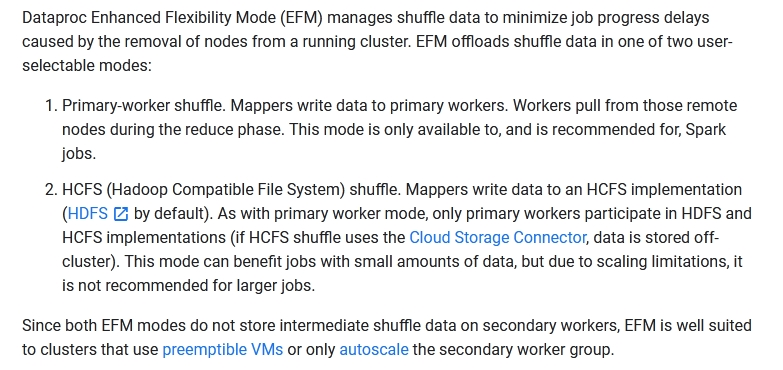You are managing a Cloud Dataproc cluster. You need to make a job run faster while minimizing costs, without losing work in progress on your clusters. What should you do?
D
Reference:
https://cloud.google.com/dataproc/docs/concepts/configuring-clusters/flex
You work for a shipping company that uses handheld scanners to read shipping labels. Your company has strict data privacy standards that require scanners to only transmit tracking numbers when events are sent to Kafka topics. A recent software update caused the scanners to accidentally transmit recipients' personally identifiable information (PII) to analytics systems, which violates user privacy rules. You want to quickly build a scalable solution using cloud-native managed services to prevent exposure of PII to the analytics systems. What should you do?
D
You have developed three data processing jobs. One executes a Cloud Dataflow pipeline that transforms data uploaded to Cloud Storage and writes results to
BigQuery. The second ingests data from on-premises servers and uploads it to Cloud Storage. The third is a Cloud Dataflow pipeline that gets information from third-party data providers and uploads the information to Cloud Storage. You need to be able to schedule and monitor the execution of these three workflows and manually execute them when needed. What should you do?
D
You have Cloud Functions written in Node.js that pull messages from Cloud Pub/Sub and send the data to BigQuery. You observe that the message processing rate on the Pub/Sub topic is orders of magnitude higher than anticipated, but there is no error logged in Cloud Logging. What are the two most likely causes of this problem? (Choose two.)
CE
You are creating a new pipeline in Google Cloud to stream IoT data from Cloud Pub/Sub through Cloud Dataflow to BigQuery. While previewing the data, you notice that roughly 2% of the data appears to be corrupt. You need to modify the Cloud Dataflow pipeline to filter out this corrupt data. What should you do?
B
You have historical data covering the last three years in BigQuery and a data pipeline that delivers new data to BigQuery daily. You have noticed that when the
Data Science team runs a query filtered on a date column and limited to 30`"90 days of data, the query scans the entire table. You also noticed that your bill is increasing more quickly than you expected. You want to resolve the issue as cost-effectively as possible while maintaining the ability to conduct SQL queries.
What should you do?
A
You operate a logistics company, and you want to improve event delivery reliability for vehicle-based sensors. You operate small data centers around the world to capture these events, but leased lines that provide connectivity from your event collection infrastructure to your event processing infrastructure are unreliable, with unpredictable latency. You want to address this issue in the most cost-effective way. What should you do?
B
You are a retailer that wants to integrate your online sales capabilities with different in-home assistants, such as Google Home. You need to interpret customer voice commands and issue an order to the backend systems. Which solutions should you choose?
C
Your company has a hybrid cloud initiative. You have a complex data pipeline that moves data between cloud provider services and leverages services from each of the cloud providers. Which cloud-native service should you use to orchestrate the entire pipeline?
D
You use a dataset in BigQuery for analysis. You want to provide third-party companies with access to the same dataset. You need to keep the costs of data sharing low and ensure that the data is current. Which solution should you choose?
A